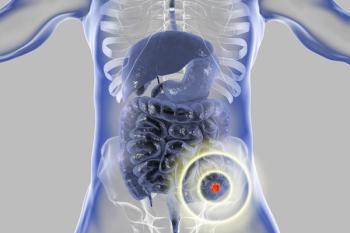
Oncology NEWS International
- Oncology NEWS International Vol 14 No 1
- Volume 14
- Issue 1
High pCR Rate With Neoadjuvant Chemo-RT in Rectal Ca
ATLANTA-Two neoadjuvant chemoradiation regimens-one using hyperfractionated radiation therapy and one using intensified chemotherapy-achieved pathologic complete responses (pCRs) in more than one-fourth of patients with advanced distal rectal cancer, according to a randomized phase II study. Mohammed Mohiuddin, MD, presented the findings at the 46th Annual Meeting of the American Society for Therapeutic Radiology and Oncology (abstract 16).
ATLANTATwo neoadjuvant chemoradiation regimensone using hyperfractionated radiation therapy and one using intensified chemotherapyachieved pathologic complete responses (pCRs) in more than one-fourth of patients with advanced distal rectal cancer, according to a randomized phase II study. Mohammed Mohiuddin, MD, presented the findings at the 46th Annual Meeting of the American Society for Therapeutic Radiology and Oncology (abstract 16).
Many trials are assessing neoadjuvant chemoradiotherapy for rectal cancer; however, the optimal approach remains uncertain because of the differing eligibility criteria, radiation doses, and chemotherapy regimens used, said Dr. Mohiuddin, chairman of radiation medicine, University of Kentucky, Lexington.
"But one thing, just to be clear, that certainly emerges from these and other studies is that the rate of pCR seems to be quite significantly higher with chemoradiation than with radiation alone," he noted, with those rates ranging from 10% to 30%. "With it is, of course, the price you pay in terms of normal tissue toxicity," he added, with rates of toxicity ranging from 15% to 40%.
Patients were eligible for the study (RTOG-0012) if they had clinical T3 or T4 rectal cancer located 0 to 9 cm from the dentate line. They were stratified by T stage and then assigned to two treatment groups.
The first group received fluorouracil (5-FU) by continuous infusion and hyperfractionated radiation therapy with a boost (total dose, 55 and 60 Gy for T3 and T4 cancer, respectively). The second group received 5-FU by continuous infusion, irinotecan (Camptosar) once weekly, and conventional radiation therapy with a boost (total dose, 50 and 55 Gy for T3 and T4 cancers, respectively). The patients underwent surgery 4 to 10 weeks after completing therapy.
Analyses were based on 102 patients who had a mean age of about 57 years, two-thirds of whom were men. Most of the patients had stage T3 disease (72%) and a Zubrod score of 0 (77%).
Similar Toxicity
Rates of acute and late toxicities were generally similar between arms, Dr. Mohiuddin said. "Bowel toxicity especially was relatively modest in both arms of the study," he noted. The proportion of patients with a worst toxicity rated as grade 3 was somewhat higher in the intensified chemotherapy arm than in the hyperfractionated radiation therapy arm (47% vs 36%), while the proportion with grade 4 toxicity was similar (6% vs 4%).
At the time of surgery, identical proportions (80%) of patients in each group had a downstaging of their disease, Dr. Mohiuddin said, noting that such downstaging enables minimal surgery and dramatically improves survival. "The surgically resectable rate was 93% in these patients," he added. "Essentially all of the patients with T4 cancers were downstaged in both arms of the study, and all of them underwent surgical resection, which was quite significant."
pCR Rates
Similarly, the pCR rates were identical and high in both treatment groups, with 28% of patients who underwent surgery having such a response (see Table). The pCR rates were 32% and about 19% among patients with T3 and T4 cancers, respectively.
In discussing similar neoadjuvant studies reported at the 2004 American Society of Clinical Oncology meeting (with pCR rates ranging from 5% to 21%), Dr. Mohiuddin noted, "The thing that stands out is that the results from RTOG-0012 are about the best results that have been reported in terms of pCR rate, and the key difference that you find is the radiation dose, which was significantly higher than what you see in most other studies. The pCR response rate of 28% is achievable as long as you give an appropriate dose of preoperative radiation in either arm, and that seems to be the key."
According to Dr. Mohiuddin, that rate can be viewed as a baseline value for future trials in which added approaches, such as use of molecular targeted agents or further dose intensification, might yield even higher rates.
"If you are really looking at improving outcomes, you really need to get to more of 40% to 50% pCR rates, and I think we can do that with again further intensification of the radiation dose, especially for T4 cancers," he concluded. "The current RTOG trial is looking at the irinotecan/5-FU arm and randomizing that against an oxaliplatin [Eloxatin]/ 5-FU arm, but both arms are using conventional radiation . . . to 50.4 Gy for T3 and 55 Gy for T4 cancers."
Articles in this issue
almost 21 years ago
Efforts Continue to Uncover Early Indicators of Clinical Effectalmost 21 years ago
Avastin/FOLFOX4 Improves Overall Survival in Pts With Advanced Colon Caalmost 21 years ago
Study Supports Need for RT Post-Lumpectomy in Most Ptsalmost 21 years ago
BMS-354825 Overcomes Imatinib Resistance in CMLalmost 21 years ago
Kepivance Approved for Oral Mucositis in Hematologic CaNewsletter
Stay up to date on recent advances in the multidisciplinary approach to cancer.
















































































